Syrup Gauges/Pumps
The introduction and on-going
development of syrup gauges/pumps substantially improved the bottling
process, allowing operators to rapidly dispense accurately measured
quantities of syrup into each bottle.
The following three drawings from Charles Sulz’s 1888 book
A Treatise on Beverages or
The Complete Practical Bottler show syrup gauges/pumps
produced by Matthews, Putnam, and Slocum.
The illustrated Putnam gauge is quite similar to the version
Henry W. Putnam patented October 29, 1861 (U.S. Patent No. 33,602).
Although Putnam’s gauge was expensive at $20, it was a welcomed
labor-saving device.
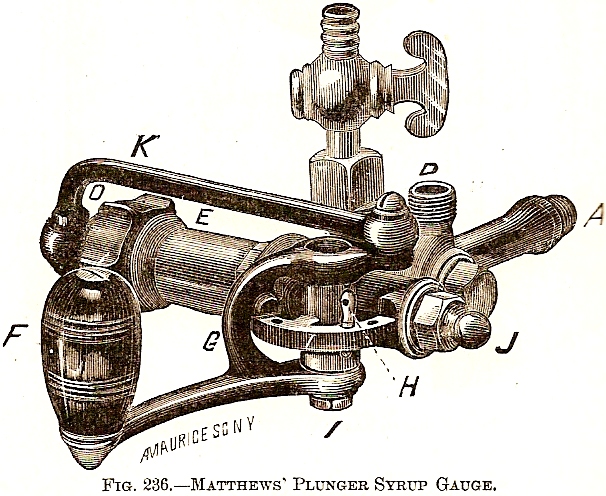
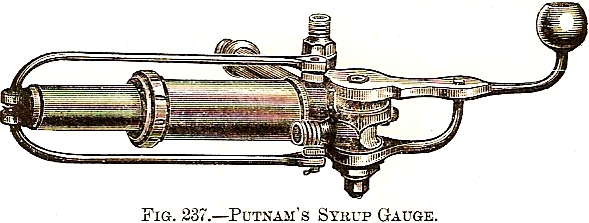

Sullz’s
general comments about these syrup gauges/pumps included:
Their capacity is from ¾ of an ounce to 4 ounces of
syrup per stroke, and the desired quantity is regulated by means of a
movable pin or screw which guides the pumping strokes…All these syrup
gauges or pumps are made with close-fitting hard rubber plungers, which
fill the entire cylinder – that is to say, they admit and discharge the
syrup from the same end of the piston.
It is necessary to have the syrup cans or tanks elevated in order
to deliver the syrup to the syrup gauges.
A gauge with suction pump will
draft the
syrup whether elevated or not.
The syrup gauges and pumps are made of brass and ought to be
carefully and frequently tin or silver lined inside, as the acidified
syrups which are compelled to pass through all parts of it would soon
affect the metallic body and get tainted with metallic impurities
itself, and consequently contaminate the beverages.
We have seen syrup
gauges entirely covered with verdigris on the inside, and
this is another point where the carbonator should exercise the closest
scrutiny and cleanliness.
The gauge must be frequently cleansed, and whenever the lining is worn
out at once re-lined.
Here’s the syrup-pump offered by James W. Tufts in his 1888 book The Manufacture & Bottling of Carbonated Beverages:
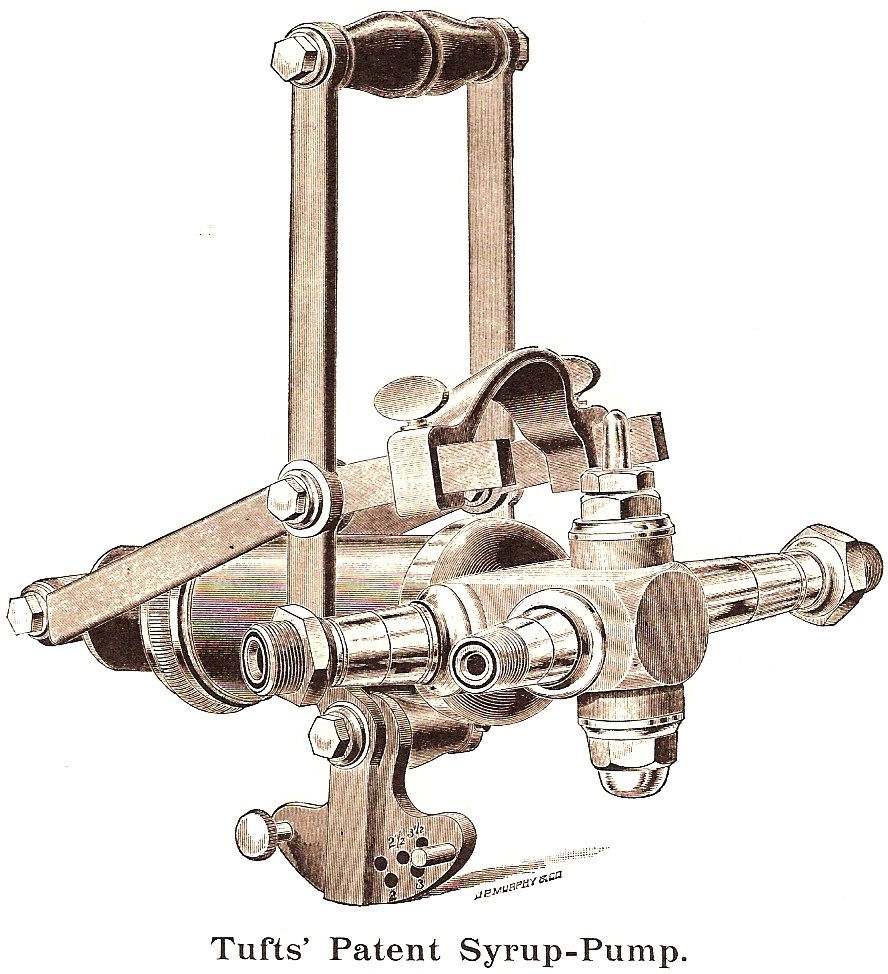
Tufts’
description and directions mentioned:
This is the only pump made which is lined throughout,
including the barrel. The
solid plunger and the syrup-valves are of hard rubber; they require no
packing, and are not liable to get out of order.
The water-valve being on the outside is convenient to repack or
rewasher when necessary.
This is a section pump, and it is not necessary to have the syrup-can on
a shelf, on or hung to the ceiling, as it will draft from any place that
any suction pump will draft from.
The beverages which pass through this pump will be absolutely
free from contamination.
The bottler who is so particular to have his fountains lined with
block-tin to protect his soda and mineral-waters from metallic taint,
and who is compelled to pass these waters and his acid-syrups through a
syrup-pump or gauge lined with verdigris, will appreciate this pump.
Directions.
In adjusting this pump to the filling-head, place a
washer in the female of the filling-head, and screw the pump in until it
brings up firmly on the washer.
Turn the pump around until it is in a level position, convenient
for working, then screw up the loose nut on the outlet passage of pump
against the filling-head.
This nut is intended for a check-nut, and must be screwed up tight to
prevent the pump from turning when in use.
At the end of the upright arm is a disc with screw pin
and poles for gauging the quantity of syrup.
The outside holes are for 1 oz., 2 oz., and 3 oz., and the inside
holes for 1 ½ oz., 2 ½ oz., and 3 ½ oz.
For four oz., let the arm strike the stationary pin; placing the
movable pin for safe keeping in the hole which is not marked.
The operation of the pump is a forward and back direct
motion, making the stroke very short.
The opening of the soda-water vale is at the extreme end of the
stroke, and the syrup is all discharged from the barrel before the
water-valve is opened.
The pump may be adjusted as desired, to open the
water-valve wide for quart bottles or slightly for half-pint bottles, by
moving the slide on the arms and setting it by means of the
thumb-screws.
In the late 1860s The Firm of John Matthews marketed
the first counter-pressure snifting valve.
This valve directed gas expelled
from a bottle during filling directly back into the carbonated water
supply hose where it could be re-used.
This not only conserved gas, it created a uniform pressure in the
cylinder and bottle, reducing foaming in the bottles to a minimum.
Snifting was a highly important step in the bottling process.
Although developments such as syrup gauges and pumps
greatly improved the filling process, major bottle closure improvements
were slow in coming and bottlers continued to seal bottles with corks.
As late as 1888, Tufts was offering the following capping and
wiring supplies:
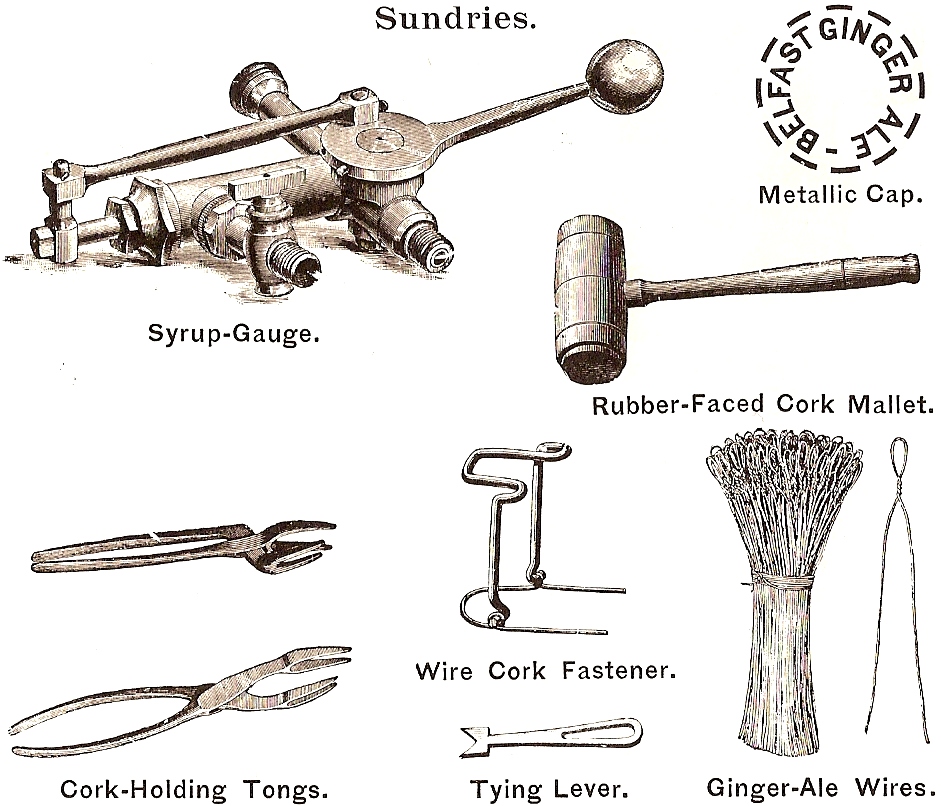
The
descriptions accompanying Tufts’ listings (plagiarized from Charles
Sulz’s 1888 A Treatise on
Beverages or The Complete Practical Bottler) detail how
bottlers utilized these tools and supplies:
Capping and Wiring.
The tyer will be found of assistance in capping and
wiring. It is shown
attached to the end of the bottling-table and consists of an iron arch
sufficiently high to allow the bottle to be placed under it, and of a
movable platform which can be raised by means of a pedal.
The bottle while under the cork-plunger of bottling–table is
seized with the cork-holding tongs and placed on the platform, and by
pressing on the pedal with
the foot, the bottle is brought up against the top of the arch, thus
holding in the cork while the tongs are removed and the wire applied.
The price complete, ready to attach is $7.00.
The best annealed broom wire should be used.
It should be cut in pieces of proper length and each piece folded
double, and twisted six or eight times to form a loop at the end.
The helper, on taking the filled bottle from the table with the
cork-holding tongs and placing it under the tyer, quickly seizes a wire
with his right hand, puts it around the neck of the bottle, giving it a
couple of twists to hold it firmly in place, and passes the ends through
the loop, draws tight, cuts off the superfluous wire with shears, and
presses the ends into the cork.
The pressure in the bottle has by this time forced the cork
against the wire, so as to make a neat looking job.
When the tin foil is used in capping, it is previously
cut in sheets of the proper size.
The operator places a sheet on the palm of his left hand, covers
it with paste, and taking the bottle in his right hand, he places the
neck on the sheet of tin foil, and by a dexterious turn wraps the latter
about the bottle neck and cork.
There are many accessories which can be advantageously
used in wiring and capping, if desired; such as the cork-holding tongs,
for taking bottle from bottling-bench; the tying-lever for tightening
wire over cork; the rubber-faced mallet for driving back a cork which is
escaping; the metallic cap, often used in place of tin foil.
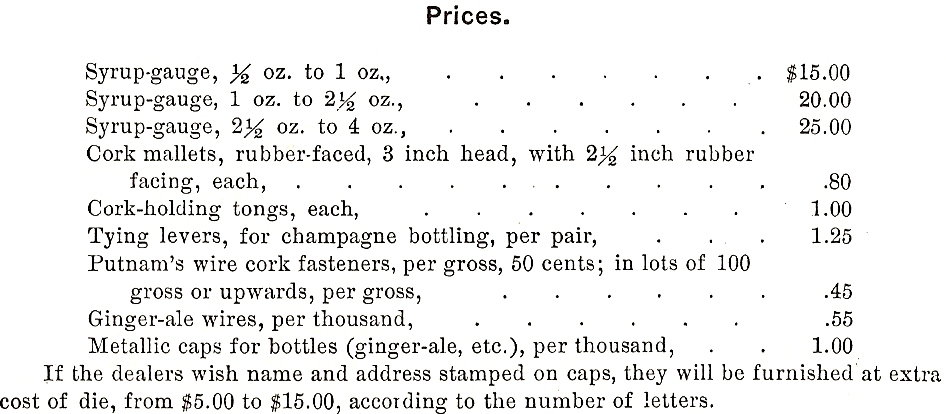
 HutchBook.com
HutchBook.com